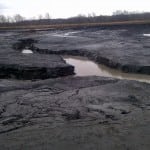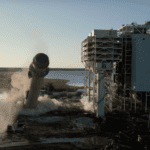After 64 years as a landmark in Wilmington, N.C., one of three boiler units at Duke Energy’s retired coal-fired L.V. Sutton Plant crumpled in a dusty heap of contorted steel and splintered glass on April 10.
The implosion is the first of three similar events to take place at the Sutton Plant. The next is scheduled in May and the final demolition event will take place in the fall.
The plant was built in the aftermath of Hurricane Hazel—a catastrophe in 1954 that caused 95 fatalities in the U.S. (and hundreds of others along the storm’s path). That hurricane churned up a storm surge so severe that it annihilated most buildings along the waterfront between the North Carolina state line and Cape Fear.
The 575-MW Sutton plant has since weathered many more storms, Duke Energy said. The company recalled a moment during Hurricane Floyd in 1999 when, in torrential rain, “several of the motors and pumps ran continuously underwater throughout the storm and afterwards had to be sent off for repairs.”
The plant was retired in November 2013 when a new, gas-fired 625-MW combined cycle unit began operation.
Duke Energy noted that it wasn’t alone in demolishing outdated power plants: “One major reason for closing coal plants is tighter regulations on emissions. Cost is another factor. With natural gas prices so low, it’s more economical in many cases to make electricity using gas rather than coal.”
Since 2013, the team has prepared the site for full demolition work that included removing two iconic red-and-white striped smokestacks. “Using a ring-like structure attached to the smokestacks, crews have torn down the structures piece by piece. The company expects this phase to be completed in the coming weeks,” it said.
Meanwhile, the company is also working to move coal ash from the plant to a “fully lined structural fill” at the Brickhaven mine site in central North Carolina.
“In January, after constructing a nearly two-mile long rail line into the mine site, the company shifted to moving the majority of ash from the plant by rail to expedite this process and minimize the impact to the local community. Crews have excavated around 200,000 tons of coal ash from the Sutton Plant site,” it said.
—Sonal Patel, associate editor (@POWERmagazine, @sonalcpatel)










